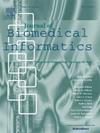Low-cost algorithms for clinical notes phenotype classification to enhance epidemiological surveillance: A case study
IF 4.5
2区 医学
Q2 COMPUTER SCIENCE, INTERDISCIPLINARY APPLICATIONS
引用次数: 0
Abstract
Objective:
Our study aims to enhance epidemic intelligence through event-based surveillance in an emerging pandemic context. We classified electronic health records (EHRs) from La Rioja, Argentina, focusing on predicting COVID-19-related categories in a scenario with limited disease knowledge, evolving symptoms, non-standardized coding practices, and restricted training data due to privacy issues.
Methods:
Using natural language processing techniques, we developed rapid, cost-effective methods suitable for implementation with limited resources. We annotated a corpus for training and testing classification models, ranging from simple logistic regression to more complex fine-tuned transformers.
Results:
The transformer-based, Spanish-adapted models BETO Clínico and RoBERTa Clínico, further pre-trained with an unannotated portion of our corpus, were the best-performing models (F1= 88.13% and 87.01%). A simple logistic regression (LR) model ranked third (F1=85.09%), outperforming more complex models like XGBoost and BiLSTM. Data classified as COVID-confirmed using LR and BETO Clínico exhibit stronger time-series Pearson correlation with official COVID-19 case counts from the National Health Surveillance System (SNVS 2.0) in La Rioja province compared to the correlations observed between the International Code of Diseases (ICD-10) codes and the SNVS 2.0 data (0.840, 0.873, and 0.663, p-values ). Both models have a good Pearson correlation with ICD-10 codes assigned to the clinical notes for confirmed (0.940 and 0.902) and for suspected cases (0.960 and 0.954), p-values .
Conclusion:
This study shows that simple, resource-efficient methods can achieve results comparable to complex approaches. BETO Clínico and LR strongly correlate with official data, revealing uncoded confirmed cases at the pandemic’s onset. Our results suggest that annotating a smaller set of EHRs and training a simple model may be more cost-effective than manual coding. This points to potentially efficient strategies in public health emergencies, particularly in resource-limited settings, and provides valuable insights for future epidemic response efforts.

用于临床笔记表型分类的低成本算法,以加强流行病学监测:案例研究
目的:本研究旨在通过基于事件的监测,在新出现的大流行背景下增强流行病情报。我们对来自阿根廷拉里奥哈的电子健康记录(EHRs)进行了分类,重点是在疾病知识有限、症状不断变化、编码实践非标准化以及由于隐私问题而限制培训数据的情况下预测与covid -19相关的类别。方法:利用自然语言处理技术,在资源有限的情况下,开发出快速、经济有效的方法。我们注释了一个用于训练和测试分类模型的语料库,范围从简单的逻辑回归到更复杂的微调变压器。结果:基于转换器的西班牙语改编模型BETO Clínico和RoBERTa Clínico,进一步使用我们的语料库的未注释部分进行预训练,是表现最好的模型(F1= 88.13%和87.01%)。简单逻辑回归(LR)模型排名第三(F1=85.09%),优于XGBoost和BiLSTM等更复杂的模型。与国际疾病法典(ICD-10)代码与SNVS 2.0数据之间的相关性相比,使用LR和BETO Clínico分类为COVID-19确诊的数据与拉里奥哈省国家卫生监测系统(SNVS 2.0)的官方COVID-19病例数显示出更强的时间序列Pearson相关性(0.840、0.873和0.663,p值≤3×10−7)。两种模型均与分配给临床记录的ICD-10代码具有良好的Pearson相关性,确诊病例(0.940和0.902)和疑似病例(0.960和0.954),p值≤1.7×10−18。结论:本研究表明,简单、资源高效的方法可以达到与复杂方法相当的效果。BETO Clínico和LR与官方数据密切相关,揭示了大流行开始时未编码的确诊病例。我们的研究结果表明,注释更小的电子病历集并训练一个简单的模型可能比手动编码更具成本效益。这指出了在突发公共卫生事件中,特别是在资源有限的情况下可能有效的战略,并为未来的流行病应对工作提供了宝贵的见解。
本文章由计算机程序翻译,如有差异,请以英文原文为准。
求助全文
约1分钟内获得全文
求助全文
来源期刊

Journal of Biomedical Informatics
医学-计算机:跨学科应用
CiteScore
8.90
自引率
6.70%
发文量
243
审稿时长
32 days
期刊介绍:
The Journal of Biomedical Informatics reflects a commitment to high-quality original research papers, reviews, and commentaries in the area of biomedical informatics methodology. Although we publish articles motivated by applications in the biomedical sciences (for example, clinical medicine, health care, population health, and translational bioinformatics), the journal emphasizes reports of new methodologies and techniques that have general applicability and that form the basis for the evolving science of biomedical informatics. Articles on medical devices; evaluations of implemented systems (including clinical trials of information technologies); or papers that provide insight into a biological process, a specific disease, or treatment options would generally be more suitable for publication in other venues. Papers on applications of signal processing and image analysis are often more suitable for biomedical engineering journals or other informatics journals, although we do publish papers that emphasize the information management and knowledge representation/modeling issues that arise in the storage and use of biological signals and images. System descriptions are welcome if they illustrate and substantiate the underlying methodology that is the principal focus of the report and an effort is made to address the generalizability and/or range of application of that methodology. Note also that, given the international nature of JBI, papers that deal with specific languages other than English, or with country-specific health systems or approaches, are acceptable for JBI only if they offer generalizable lessons that are relevant to the broad JBI readership, regardless of their country, language, culture, or health system.
 求助内容:
求助内容: 应助结果提醒方式:
应助结果提醒方式:


